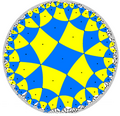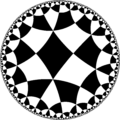| Tetrahexagonal tiling | |
|---|---|
 Poincaré disk model of the hyperbolic plane | |
| Type | Hyperbolic uniform tiling |
| Vertex configuration | (4.6) |
| Schläfli symbol | r{6,4} or rr{6,6} r(4,4,3) t0,1,2,3(∞,3,∞,3) |
| Wythoff symbol | 2 | 6 4 |
| Coxeter diagram | |
| Symmetry group | , (*642) , (*662) , (*443) , (*3232) |
| Dual | Order-6-4 quasiregular rhombic tiling |
| Properties | Vertex-transitive edge-transitive |
In geometry, the tetrahexagonal tiling is a uniform tiling of the hyperbolic plane. It has Schläfli symbol r{6,4}.
Constructions
There are for uniform constructions of this tiling, three of them as constructed by mirror removal from the kaleidoscope. Removing the last mirror, , gives , (*662). Removing the first mirror , gives , (*443). Removing both mirror as , leaving (*3232).
| Uniform Coloring |

|

|

|

|
|---|---|---|---|---|
| Fundamental Domains |
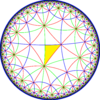
|
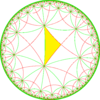
|
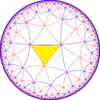
|
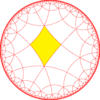
|
| Schläfli | r{6,4} | r{4,6}1⁄2 | r{6,4}1⁄2 | r{6,4}1⁄4 |
| Symmetry | (*642) |
= (*662) |
= (*443) |
= (*3232) |
| Symbol | r{6,4} | rr{6,6} | r(4,3,4) | t0,1,2,3(∞,3,∞,3) |
| Coxeter diagram |
Symmetry
The dual tiling, called a rhombic tetrahexagonal tiling, with face configuration V4.6.4.6, and represents the fundamental domains of a quadrilateral kaleidoscope, orbifold (*3232), shown here in two different centered views. Adding a 2-fold rotation point in the center of each rhombi represents a (2*32) orbifold.
Related polyhedra and tiling
| *n42 symmetry mutations of quasiregular tilings: (4.n) | ||||||||
|---|---|---|---|---|---|---|---|---|
| Symmetry *4n2 |
Spherical | Euclidean | Compact hyperbolic | Paracompact | Noncompact | |||
| *342 |
*442 |
*542 |
*642 |
*742 |
*842 ... |
*∞42 |
| |
| Figures | 
|

|

|

|

|

|

|
|
| Config. | (4.3) | (4.4) | (4.5) | (4.6) | (4.7) | (4.8) | (4.∞) | (4.ni) |
| Symmetry mutation of quasiregular tilings: (6.n) | |||||||||||
|---|---|---|---|---|---|---|---|---|---|---|---|
| Symmetry *6n2 |
Euclidean | Compact hyperbolic | Paracompact | Noncompact | |||||||
| *632 |
*642 |
*652 |
*662 |
*762 |
*862 ... |
*∞62 |
| ||||
| Quasiregular figures configuration |
 6.3.6.3 |
 6.4.6.4 |
 6.5.6.5 |
 6.6.6.6 |
 6.7.6.7 |
 6.8.6.8 |
 6.∞.6.∞ |
6.∞.6.∞ | |||
| Dual figures | |||||||||||
| Rhombic figures configuration |
 V6.3.6.3 |
 V6.4.6.4 |
 V6.5.6.5 |
 V6.6.6.6 |
V6.7.6.7 |
 V6.8.6.8 |
 V6.∞.6.∞ |
||||
| Uniform tetrahexagonal tilings | |||||||||||
|---|---|---|---|---|---|---|---|---|---|---|---|
| Symmetry: , (*642) (with (*662), (*443) , (*3222) index 2 subsymmetries) (And (*3232) index 4 subsymmetry) | |||||||||||
= = = |
= |
= = = |
= |
= = = |
= |
||||||

|

|

|

|

|

|

| |||||
| {6,4} | t{6,4} | r{6,4} | t{4,6} | {4,6} | rr{6,4} | tr{6,4} | |||||
| Uniform duals | |||||||||||

|

|

|

|

|

|

| |||||
| V6 | V4.12.12 | V(4.6) | V6.8.8 | V4 | V4.4.4.6 | V4.8.12 | |||||
| Alternations | |||||||||||
(*443) |
(6*2) |
(*3222) |
(4*3) |
(*662) |
(2*32) |
(642) | |||||
= |
= |
= |
= |
= |
= |
||||||

|

|

|

|

|

|

| |||||
| h{6,4} | s{6,4} | hr{6,4} | s{4,6} | h{4,6} | hrr{6,4} | sr{6,4} | |||||
| Uniform hexahexagonal tilings | ||||||
|---|---|---|---|---|---|---|
| Symmetry: , (*662) | ||||||
= |
= |
= |
= |
= |
= |
= |

|

|

|

|

|

|

|
| {6,6} = h{4,6} |
t{6,6} = h2{4,6} |
r{6,6} {6,4} |
t{6,6} = h2{4,6} |
{6,6} = h{4,6} |
rr{6,6} r{6,4} |
tr{6,6} t{6,4} |
| Uniform duals | ||||||

|

|

|

|

|

|

|
| V6 | V6.12.12 | V6.6.6.6 | V6.12.12 | V6 | V4.6.4.6 | V4.12.12 |
| Alternations | ||||||
(*663) |
(6*3) |
(*3232) |
(6*3) |
(*663) |
(2*33) |
(662) |

|

|

|

|

| ||
| h{6,6} | s{6,6} | hr{6,6} | s{6,6} | h{6,6} | hrr{6,6} | sr{6,6} |
| Uniform (4,4,3) tilings | ||||||||||
|---|---|---|---|---|---|---|---|---|---|---|
| Symmetry: (*443) | (443) |
(3*22) |
(*3232) | |||||||

|

|

|

|

|

|

|

|

|

|

|
| h{6,4} t0(4,4,3) |
h2{6,4} t0,1(4,4,3) |
{4,6}/2 t1(4,4,3) |
h2{6,4} t1,2(4,4,3) |
h{6,4} t2(4,4,3) |
r{6,4}/2 t0,2(4,4,3) |
t{4,6}/2 t0,1,2(4,4,3) |
s{4,6}/2 s(4,4,3) |
hr{4,6}/2 hr(4,3,4) |
h{4,6}/2 h(4,3,4) |
q{4,6} h1(4,3,4) |
| Uniform duals | ||||||||||

|

|

|

|
|||||||
| V(3.4) | V3.8.4.8 | V(4.4) | V3.8.4.8 | V(3.4) | V4.6.4.6 | V6.8.8 | V3.3.3.4.3.4 | V(4.4.3) | V6 | V4.3.4.6.6 |
| Similar H2 tilings in *3232 symmetry | ||||||||
|---|---|---|---|---|---|---|---|---|
| Coxeter diagrams |
||||||||
| Vertex figure |
6 | (3.4.3.4) | 3.4.6.6.4 | 6.4.6.4 | ||||
| Image | 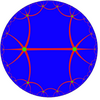
|

|

|

| ||||
| Dual | 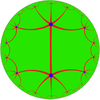
|

| ||||||
See also
References
- John H. Conway, Heidi Burgiel, Chaim Goodman-Strauss, The Symmetries of Things 2008, ISBN 978-1-56881-220-5 (Chapter 19, The Hyperbolic Archimedean Tessellations)
- "Chapter 10: Regular honeycombs in hyperbolic space". The Beauty of Geometry: Twelve Essays. Dover Publications. 1999. ISBN 0-486-40919-8. LCCN 99035678.
External links
- Weisstein, Eric W. "Hyperbolic tiling". MathWorld.
- Weisstein, Eric W. "Poincaré hyperbolic disk". MathWorld.
- Hyperbolic and Spherical Tiling Gallery
- KaleidoTile 3: Educational software to create spherical, planar and hyperbolic tilings
- Hyperbolic Planar Tessellations, Don Hatch
| Tessellation | |||||||||||||
|---|---|---|---|---|---|---|---|---|---|---|---|---|---|
|   | ||||||||||||
| |||||||||||||
| |||||||||||||
| |||||||||||||

